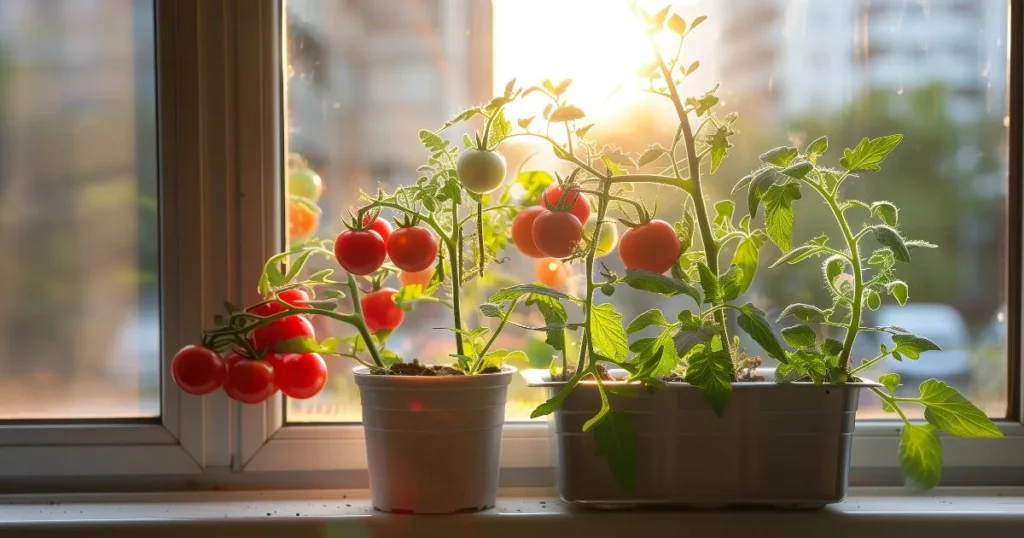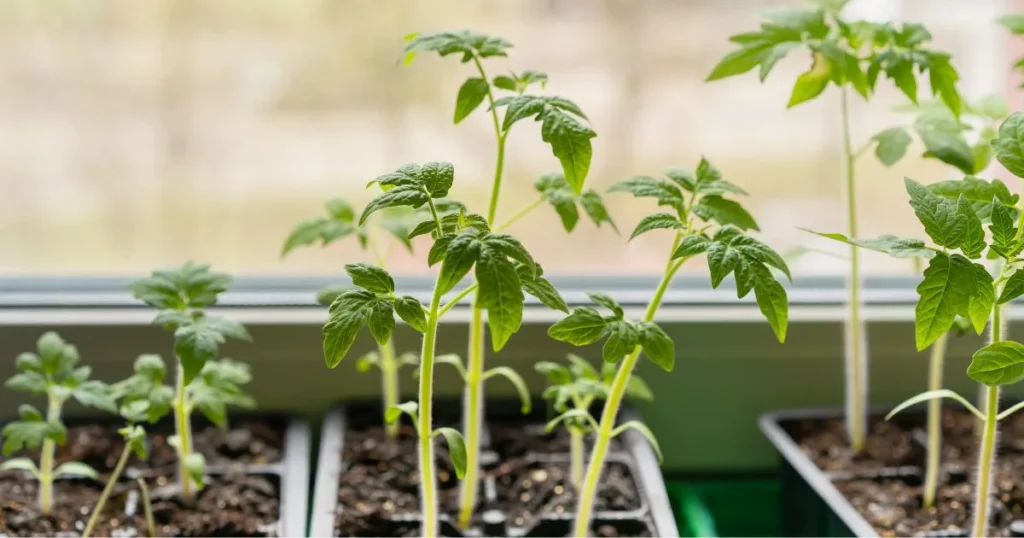Table of Contents
Introduction of How to plant Tomatoes Inside:
Growing tomatoes indoors is a rewarding and satisfying way to have fresh, organic produce right at your fingertips, even if you have limited outdoor space. Tomatoes are versatile and easy to grow indoors with the proper care and attention. This guide will walk you through the steps of planting and cultivating tomatoes inside your home, from choosing the right varieties to harvesting your first crop. Whether you’re a beginner or a seasoned gardener, growing tomatoes indoors can be both enjoyable and beneficial. Let’s dive into how to plant tomatoes inside and ensure you get a fruitful harvest.
Choosing the Right Tomato Varieties
One of the first steps to successfully growing tomatoes indoors is selecting the right variety. Since space is often limited indoors, you’ll want to choose varieties that are compact, require less space, and are suitable for container gardening.
Best Indoor Tomato Varieties
- Tiny Tim: A dwarf variety that grows well in containers, producing small cherry-sized tomatoes. This plant is perfect for small indoor spaces.
- Patio Princess: A compact variety ideal for pots, it produces small to medium-sized tomatoes and grows to about 18 inches tall.
- Bush Goliath: This variety produces medium-sized tomatoes and is a perfect option for indoor gardeners with limited space.
- Window Box Roma: Great for growing in window boxes, this variety yields small plum tomatoes ideal for sauces and cooking.
- Tiny Tims: These cherry tomatoes are an excellent choice for growing indoors in containers and have a fast-growing nature, making them perfect for small spaces.
Factors to Consider When Choosing Varieties
- Size of the Plant: Choose compact or bush-type tomatoes that grow well in containers and have a manageable size.
- Light Needs: Some varieties need more light than others. Ensure the variety you choose is suitable for indoor light conditions.
- Taste: While smaller varieties are often easier to grow indoors, consider the flavor and purpose of the tomatoes you want (e.g., fresh eating, sauces, or salads).
Selecting Containers and Soil
To grow tomatoes indoors, it’s crucial to select the right containers and soil. Proper drainage and soil quality will help ensure healthy growth.
Choosing the Right Container
Tomato plants need ample space for their roots to grow, so make sure you choose a container that will accommodate the plant’s size as it matures.
- Size of the Container: Choose a pot that is at least 12 inches deep, as tomatoes have deep root systems. Larger pots give roots more room to spread, which helps produce better yields.
- Drainage: Ensure that the container has drainage holes to prevent water from accumulating at the bottom, which could cause root rot.
- Material: Plastic and clay pots are common choices. Plastic pots retain moisture longer, while clay pots are more breathable but may dry out faster.
Selecting the Right Soil
Tomatoes need rich, well-draining soil to thrive indoors. Choose a high-quality, all-purpose potting mix that is light and airy to prevent waterlogging.
- Soil Composition: A mix that includes peat, perlite, and compost works well for indoor tomatoes. You can also add some sand to improve drainage.
- Avoid Garden Soil: It may contain pests, diseases, or poor drainage, which are unsuitable for container growth.

Planting Tomatoes
Now that you’ve chosen the right tomato variety and prepared the container and soil, it’s time to start planting!
Step-by-Step Guide to Planting Tomatoes
- Starting Seeds Indoors: Begin by planting tomato seeds indoors about 6-8 weeks before the last frost date. Use seed trays or small pots with a seed-starting mix.
- Germination: Place the seeds in a warm location with temperatures around 70-80°F (21-27°C). They should germinate in about 5-10 days.
- Transplanting Seedlings: When the seedlings have developed their first set of true leaves, it’s time to transplant them into their final pots. Gently remove them from the seed tray and plant them in the larger container.
- Planting Depth: Plant your tomato seedlings deep in the soil to encourage strong root development. Bury the plant up to the first set of true leaves.
- Watering: After transplanting, water thoroughly but ensure that the soil drains well.
Watering and Fertilizing
- Watering: Keep the soil moist, but don’t overwater, as this can lead to root rot. Water when the top inch of the soil feels dry.
- Fertilizing: Tomatoes need regular feeding. Use a balanced fertilizer that is rich in phosphorus, which encourages fruit development. Feed the plants every 2-3 weeks during the growing season.
Providing Light and Temperature
Indoor tomatoes need proper lighting and temperature control to thrive.
Light Requirements for Indoor Tomatoes
Tomatoes need a lot of light to produce fruit. Ideally, they should receive 6-8 hours of direct sunlight each day.
- Natural Light: If you have a sunny spot near a south-facing window, that’s the best location for your tomatoes. If not, you can supplement with grow lights.
- Grow Lights: LED or fluorescent grow lights are perfect for indoor tomatoes. Position the lights 6-12 inches above the plants and leave them on for 12-16 hours a day.
Temperature Considerations
- Ideal Temperature: Tomatoes thrive in temperatures between 65°F to 75°F (18°C to 24°C) during the day and 60°F to 65°F (15°C to 18°C) at night.
- Avoid Drafts: Keep your tomatoes away from cold drafts or direct air conditioning vents, which could stunt growth.
Pruning and Support
Pruning and supporting indoor tomatoes is crucial to help them grow compact and productive.
Pruning for Healthy Growth
Pruning helps to focus the plant’s energy on growing fruit, rather than excess foliage.
- Remove Suckers: Suckers are the small shoots that grow between the stem and the branches. Removing them will allow the plant to focus on producing fruit.
- Pinch off Lower Leaves: As your tomato plant grows taller, pinch off the lower leaves to improve air circulation and prevent fungal diseases.
Providing Support
As your tomatoes grow, they will need support to prevent the stems from breaking under the weight of the fruit.
- Staking: Use bamboo stakes or other sturdy supports to help your plant grow upright.
- Cages and Trellises: Tomato cages or trellises are great for supporting the plant and keeping the tomatoes off the ground.

Dealing with Pests and Diseases
Even indoors, tomatoes can be susceptible to pests and diseases, so it’s important to be proactive in prevention and treatment.
Common Tomato Pests
- Aphids: These small insects can cause damage to leaves. Use insecticidal soap or neem oil to treat them.
- Whiteflies: These pests can stunt plant growth. Use sticky traps or insecticidal soap to control infestations.
Tomato Diseases
- Fungal Diseases: Indoor tomatoes are at risk for fungal diseases such as powdery mildew. Maintain proper airflow around the plants and avoid watering from above.
- Root Rot: Overwatering is the primary cause of root rot. Ensure your pots have proper drainage to avoid this problem.
Harvesting Your Tomatoes
Once your tomatoes have reached maturity, it’s time to harvest!
How to Harvest Tomatoes
- Signs of Ripeness: Most indoor tomato varieties take 55-80 days to mature. The tomatoes should be fully colored (red, yellow, or orange, depending on the variety) and slightly soft to the touch.
- Picking Tomatoes: Gently twist or cut the tomatoes from the vine to avoid damaging the plant.
Conclusion
Growing tomatoes indoors can be a fun and fulfilling experience, allowing you to enjoy fresh tomatoes even when the weather outside isn’t suitable for outdoor gardening. By selecting the right variety, providing proper care, and managing lighting, watering, and temperature, you can easily grow tomatoes indoors all year round.
Frequently Asked Questions
Q: How much light do indoor tomatoes need?
A: Indoor tomatoes require 6-8 hours of direct sunlight each day. If you don’t have access to enough natural light, use grow lights to supplement their light requirements.
Q: Can I grow tomatoes indoors year-round?
A: Yes, tomatoes can be grown indoors year-round as long as they receive sufficient light and warmth. Using grow lights will help keep the plants healthy throughout the year.
Q: Can indoor tomatoes be grown in any container?
A: It’s best to choose containers that are at least 12 inches deep with good drainage. Larger pots provide more room for the roots to grow, which supports healthy development.
Q: How do I prevent my indoor tomatoes from getting too leggy?
A: Ensure your tomatoes are getting enough light. If they seem leggy, it’s usually because they aren’t receiving enough sunlight. Using a grow light will help prevent this.

